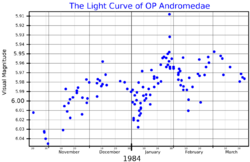Astronomy:OP Andromedae
From HandWiki
Short description: Variable star in the constellation Andromeda
| Observation data Equinox J2000.0]] (ICRS) | |
|---|---|
| Constellation | Andromeda |
| Right ascension | 01h 36m 27.1998s[2] |
| Declination | +48° 43′ 21.9998″}[2] |
| Apparent magnitude (V) | 6.27 - 6.41[3] |
| Characteristics | |
| Spectral type | K1III[3] |
| Apparent magnitude (J) | 3.794[4] |
| Apparent magnitude (H) | 3.165[4] |
| Apparent magnitude (K) | 2.914[4] |
| B−V color index | 1.2478[5] |
| Variable type | RS CVn[3] |
| Astrometry | |
| Radial velocity (Rv) | −42.12±0.14[2] km/s |
| Proper motion (μ) | RA: −15.189±0.153[2] mas/yr Dec.: −17.663±0.148[2] mas/yr |
| Parallax (π) | 6.3462 ± 0.0912[2] mas |
| Distance | 514 ± 7 ly (158 ± 2 pc) |
| Absolute magnitude (MV) | 0.37 ± 0.23[6] |
| Details | |
| Mass | 1.5 – 3[7] M☉ |
| Radius | 16.1±2.2[6] R☉ |
| Luminosity | 128.825[7] L☉ |
| Surface gravity (log g) | 2.14[7] cgs |
| Temperature | 4,490[7] K |
| Metallicity [Fe/H] | -0.10[7] dex |
| Rotational velocity (v sin i) | 7.2[7] km/s |
| Other designations | |
| Database references | |
| SIMBAD | data |
OP Andromedae is a variable star in the constellation Andromeda. Varying between magnitudes 6.27 and 6.41 over 2.36 days, it has been classified as an RS Canum Venaticorum variable, but there has not been any proof of binarity, yet.[3] It is a red giant star with a spectral classification of K1III.
OP Andromedae is one of the few red giant stars where it was detected an overabundance of 7Li.[6] The mechanism that enhances lithium in red giants is still unknown. It was proposed that those stars engulfed planets in the recent past; however, this theory was discarded since there is an overabundance of just one lithium isotope.[7]
References
- ↑ Barksdale, W. S.; Boyd, L. J.; Genet, R. M.; Chang, S.; Hall, D. S.; Ingvarsson, S. I. (1984). "Discovery that HR 454 is a Variable Star". Information Bulletin on Variable Stars 2632.
- ↑ 2.0 2.1 2.2 2.3 2.4 2.5 Brown, A. G. A. (August 2018). "Gaia Data Release 2: Summary of the contents and survey properties". Astronomy & Astrophysics 616: A1. doi:10.1051/0004-6361/201833051. Bibcode: 2018A&A...616A...1G. Gaia DR2 record for this source at VizieR.
- ↑ 3.0 3.1 3.2 3.3 "OP And database entry". Combined General Catalog of Variable Stars. CDS. http://webviz.u-strasbg.fr/viz-bin/VizieR-S?V*%20OP%20And.
- ↑ 4.0 4.1 4.2 Cutri, Roc M.; Skrutskie, Michael F.; Van Dyk, Schuyler D.; Beichman, Charles A.; Carpenter, John M.; Chester, Thomas; Cambresy, Laurent; Evans, Tracey E. et al. (2003). "VizieR Online Data Catalog: 2MASS All-Sky Catalog of Point Sources (Cutri+ 2003)". CDS/ADC Collection of Electronic Catalogues 2246: II/246. Bibcode: 2003yCat.2246....0C. http://vizier.u-strasbg.fr/viz-bin/VizieR?-source=II/246.
- ↑ Høg, E.; Fabricius, C.; Makarov, V. V.; Urban, S.; Corbin, T.; Wycoff, G.; Bastian, U.; Schwekendiek, P. et al. (2000), "The Tycho-2 catalogue of the 2.5 million brightest stars", Astronomy & Astrophysics 355: L27–L30, Bibcode: 2000A&A...355L..27H.
- ↑ 6.0 6.1 6.2 Balachandran, Suchitra C.; Fekel, Francis C.; Henry, Gregory W.; Uitenbroek, Han (2000). "Two K Giants with Supermeteoritic Lithium Abundances: HDE 233517 and HD 9746". The Astrophysical Journal 542 (2): 978–88. doi:10.1086/317055. Bibcode: 2000ApJ...542..978B.
- ↑ 7.0 7.1 7.2 7.3 7.4 7.5 7.6 Takeda, Y.; Tajitsu, A. (August 2017). "On the observational characteristics of lithium-enhanced giant stars in comparison with normal red giants". Publications of the Astronomical Society of Japan 69 (4): 978–88. doi:10.1093/pasj/psx057. Bibcode: 2017PASJ...69...74T.
 |

